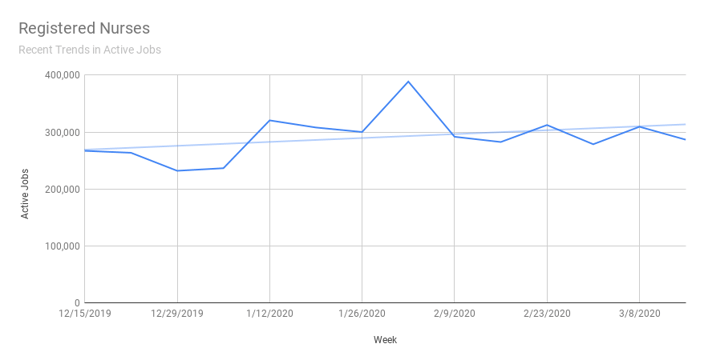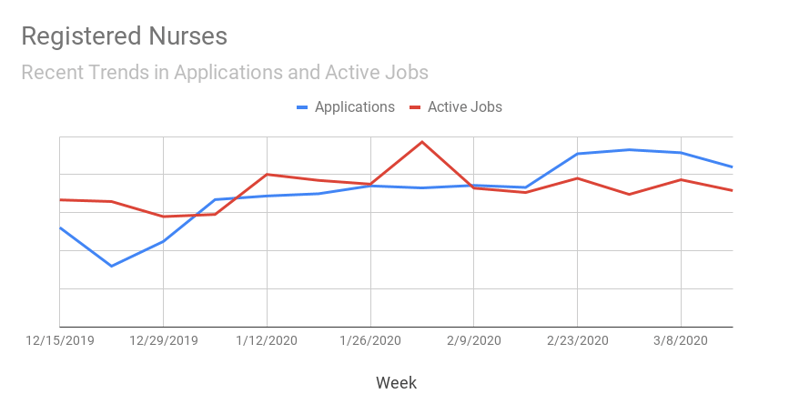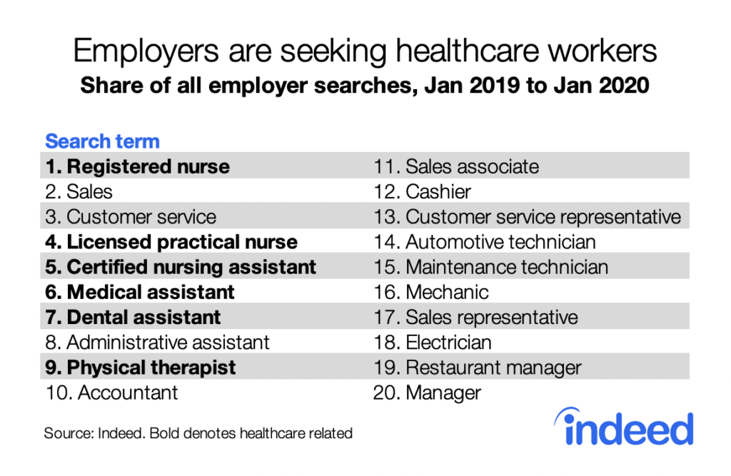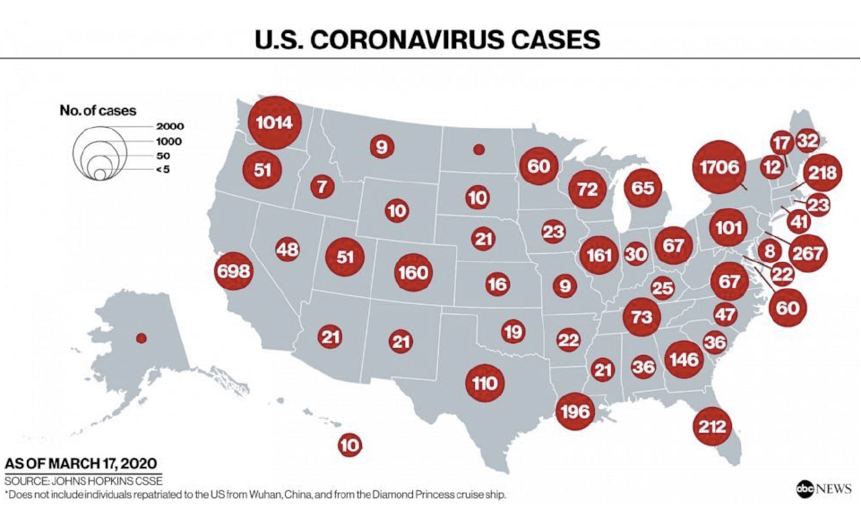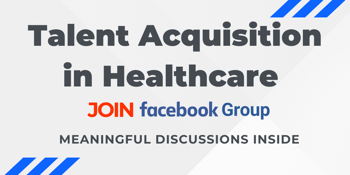Coronavirus & Nurse Recruiting
3 Actions to Retain, Support, & Attract Top Nursing Talent
Nurse staffing is a challenging area to recruit with a talent gap predicted well into the future—this was the case before Coronavirus (COVID-19) hit the US, which is expected to further widen the gap in nurse recruitment from an already limited supply of licensed professionals. Healthcare facilities across the nation are expected to face obstacles with nurse recruiting as demand soars and supply is limited.
The talent gap for recruiting nurses was an existing challenge, and the reasons for increased demand are obvious due to a pandemic, but some factors that further amplify the gap, such as active nurses being quarantined due to exposure, school closures affecting childcare, and general concerns about protecting self and family. It’s critically important that facilities understand the severity of the talent gap at this time, are proactive, and act quickly to ensure we can provide care to our nation.
At Recruitics, we're here to help. We're offering healthcare companies a free 30-minute consultation to speak with our healthcare recruitment marketing experts to discuss the situation, provide insights and advice, and review whatever else you need.
This resource includes:
- Understanding RN Talent Supply & Demand
- The Demand: A High Need for Nurse Talent
- The Supply: A Shortage of Nurse Talent
- An Action Plan for Healthcare Employers
- A Personal Note from the Author

Understanding RN Talent Supply & Demand
The reasons for “social distancing” are of course to prevent further spread of the virus, but also specifically to manage flattening the curve. The concept of flattening the curve is based on taking precautions to manage demand before it exceeds healthcare capacity as much as possible.
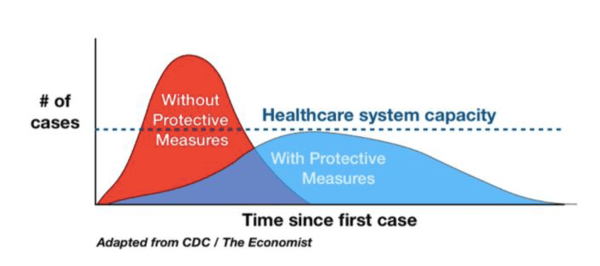
In the talent acquisition space, demand can be measured by the number of jobs or roles that need to be filled, and supply by the activity of job seekers or eligible workforce. How these two factors correlate creates what we call a “talent trade value.” Talent Trade Value is the acquisition value of a type of candidate by a combination of skill and market. Talent trade value changes daily, just like the stock market. When demand is high and supply is low, the value increases. When supply is high and demand is low, the value decreases.
In 2019, Recruitics supported nearly three million nurse jobs that impacted 11,602 companies using analytics to monitor talent supply and demand trends. The trends for 2020 thus far show that the demand for nurses has not yet materialized in active searchable jobs since the pandemic hit. Active jobs only appear to have grown less than 10% since the beginning of the year. Whether this is due to companies not being able to respond to their talent acquisition needs fast enough, or because facilities are having success filling their demand through other avenues is not yet known. The delayed response, however, is most likely due to the rapidly evolving situation.
(Data Source: Recruitics)
When the pandemic was first starting to make itself known in the U.S., the volume of nurse applications appears to have surprisingly increased and maintained 20% higher. This displays that since late February, there has not yet been a spike in new nurse jobs posted just yet, but there has been a noticeable lift in applications. This proves that those who do have active acquisition strategies or can respond quickly are at an advantage to capitalize on the current increased application activity.
(Data Source: Recruitics)
The data shows that there is increased nurse activity, but if the nurse workforce is in low supply, how could this be possible? This is most likely nurses looking to switch employers in an opportune time to make a change, which means retention matters.
[WEBINAR] "Healthcare Recruiting During a Crisis: How TA Leaders are Navigating COVID-19 & the Impact to Recruitment Marketing" - Access On Demand Now
The Demand: A High Need for Nurse Talent
The CDC’s - Interim Guidance for Healthcare Facilities states that “preserving healthcare system functioning is paramount” and that “it is critical for healthcare facilities to continue to provide care for all patients.” The CDC also warns that facilities will likely need to respond to a surge in patients requiring care.
“Staffing agencies and hospitals are preparing under the expectation that they'll be running at higher capacities, although that has largely yet to materialize,” said officials from the staffing firms Medical Solutions, Envision Healthcare, CHG Healthcare, and SCP Health.
“Italy and China took an all-hands-on-deck approach during the outbreak, with their respective governments asking retired healthcare workers to come out of retirement,” said Andrew Challenger, Vice President of the law firm, Challenger, Gray & Christmas. "That's a clear proxy to what will happen in the U.S.—there will certainly be more demand.”
For example, Washington State, which has been hit hard by the surging numbers of confirmed coronavirus cases and regrettably high numbers of fatalities, is currently hiring hundreds of nurses on top of the existing needs that were already in high demand before the outbreak.
According to Indeed, nurses were already in high demand before the pandemic with six of the top 10 job titles searched by employers in 2019 being healthcare-related and number one on the list being “Registered Nurse.”
Demand will grow in areas most affected by the virus, such as metro areas, but the situation will evolve quickly and will no doubt impact all regions. Facilities not feeling the squeeze of demand just yet have the advantage to prepare before what will inevitably come.
The Supply: A Shortage of Nurse Talent
The U.S. Bureau of Labor Statistics projects that the registered nurse workforce will grow by half a million by 2026. Despite that growth, the Bureau projects a shortage of about 204,000 nurses annually to fill new and vacant positions. However, those predictions were made before the Coronavirus pandemic and are now compounded by two main factors which create an even larger gap: the increased demand for care and further decline in available workforce supply.
People searching for “nurse jobs” on Google in January peaked to its highest ever in over five years, which was an optimistic sign for 2020. The trend normalized as expected after the “new year, new job”, which is common in general for most industries and functions, but the new normal was still well above previous years.
However, when the Coronavirus began to make a significant impact on the U.S. in March 2020, the trends of people searching for “nurse jobs” began declining so significantly that it's looking to be the lowest it's been in years. Heading further into 2020, this may be a trend of lower supply of people searching for nursing jobs.
The search term trends for “travel nurse jobs” are showing the opposite in early predictions for March 2020. They appear to be soaring to the highest levels in over five years, indicating increased interest in “travel nurse jobs,” which means opportunity.
The metro areas with the highest interest in “travel nurse jobs” at this time are also the areas that have not yet been hard hit by the Coronavirus. Facilities looking to hire travel nurses need to act fast to acquire this talent.
As the current state progresses, the nursing gap supply and demand will no doubt have an impact on both employers and employees. Employers will probably have to increase their efforts and raise wages to attract and retain the talent they need. Many facilities are already offering large bonuses and incentives to engage candidates. With falling job seeker interest and employers aggressively seeking to fill healthcare positions, nurse compensation will likely rise.

An Action Plan for Healthcare Employers
What steps should healthcare facilities take to prepare for the challenges of staffing nurses? There are three major actions: retain the current workforce, acquire additional resources, and accelerate the ability to onboard new staff.
-
-
1. Retain Your Current Nursing Workforce
-
First and foremost, you must prepare, protect, and care for your current staff so they can continue to provide care.
Nurses are a critical workforce needed in these times more than ever, and nurses are at high risk of catching the virus. If they do, they will need to self-quarantine for 14 days. More healthcare workers are ordered to self-quarantine each day. In Vacaville, California, 200 hospital workers were under quarantine after potential exposure to infected patients and unable to work for weeks, Kaiser Health News reports.
Keeping your current staff able to work is a critical initiative that helps prevent compounding the problem. The demand for nurses will continue to increase as more nurses are removed from the workforce supply. Reducing the growing gap caused by demand by protecting and caring for your current workforce is logical as well as responsible.
Designated Nursing Staff
The CDC’s guidance to all healthcare facilities to prevent spreading the virus to the community is to designate staff who will be responsible for caring for suspected or known COVID-19 patients. Inpatient and long term care facilities are specifically recommended to identify dedicated staff to care for COVID-19 patients.
Protect Your Nursing Staff
The CDC also encourages protecting healthcare personnel from COVID-19 by preparing for potential personal protective equipment, which may begin to experience supply shortages due to demand. By providing proper training and equipment, you can help keep more nurses healthy and able to deliver care to those in need. Also, you can fill care gaps by considering areas that you may be able to provide telehealth—a method proving to be an effective way to mitigate workforce issues from illness and quarantine in a tight talent market.
Care for Your Nursing Staff
Provide resources to support nurses with challenges and concerns that may prevent them from continuing to work. Give them a forum to escalate concerns or share barriers that may be developing due to the rapidly changing circumstances. Provide resources and empower them to take action to address developing trends or situations to ensure your nursing staff that their safety and concerns are heard and addressed in a timely way.
One example of a sudden trend that could significantly impact nurses’ ability to work is the recent cancellations of schools. If a nurse is unable to find child care, they may not be able to come to work. Developing a temporary childcare program to support working nurses may be more likely than replacing the nurse staff that will be out due to those circumstances.
Support Your Nursing Staff
Nurses often deliver on activities far beyond their required roles and often fill in the gaps for other roles to ensure quality care. However, supporting staff can deliver on activities that don’t require a nursing license and increase your nurses’ work-life balance. By providing supporting staff, your nurses will be able to execute the activities that require their license and skills and won’t be burdened with activities that can be delivered by others.
Communication is Key
It’s important to keep your current staff informed on policies and changes, as well as how much they are supported. Staff will appreciate proactive communication. Provide regular communications on what you are doing to protect them, how their safety is your priority, and how much they are valued by your organization.
Nurses are invaluable employees who should be treated and supported with as much value as they provide. With the current low supply and high demand, it’s more critical than ever to follow best practices to retain your current nursing workforce. Replacing your nursing staff will not only be costly, time-consuming, and damaging to your organization, but could also affect the quality of care for your patients.
-
-
2. Increase Your Available Resources
-
Prepare for an increased demand for care with additional resources, which may be challenging in an already taxed labor market for nurses.
The first step should be to call on your current staff and ask them to pick up more shifts. Also, consider offering incentives for those taking greater risks. Combat the rising demand as much as possible with resources already at hand. However, most healthcare facilities will likely require additional resources to keep up with the need for care.
Increasing nurse resource capacity on demand has typically been accomplished through two main avenues. A facility can, of course, strengthen current nurse staffing capacity by directly employing or contracting more staff, but ramping up at such a large volume so quickly may be challenging.
Activating travel nurses is also a good option to help with this growing demand and backfill as nurses who are infected or ordered to quarantine.
Right now, the CDC hasn't put any restrictions on domestic travel, but that could change. Travel nursing could then become even more difficult as a result. The time to move is now, and the longer a company takes to actively begin increasing resources, the more scarce the talent will be.
-
-
3. Accelerate Your Ability to Employ
-
The current times call for us to move as fast as the virus and its rippling impact on the world. What used to take weeks or months, now needs to take days or hours. This is not the typical “grow your business” type of acceleration—it’s an emergency response that requires removing unnecessary barriers to take immediate action.
Empowering task forces dedicated to specific areas and initiatives is a great way to allow teams to move quickly, pivot based on rapidly changing factors, and overcome barriers. However, these task forces may need to bring in additional resources to move as quickly as demand, particularly, in areas that require subject matter expertise, even if only in the short term.
For example, activating a nurse staffing agency, such as RN Network or Cross Country Nurse, contracting recruiters, or employing a recruitment marketing agency, such as Recruitics. These agencies are subject matter experts in on-demand hiring and can support the needs of facilities of various needs and sizes.
There simply is not enough time for most organizations to build their own talent pipeline and respond to such a significant and sudden increase in demand, especially compounded by an already tight talent market. Bringing a supporting agency focused on this objective may be the best option to move quickly.
Here are the areas you should review to optimize for acceleration and talent acquisition:
- Employee Value Proposition - An EVP “defines the value employees can expect to receive from a company and the value they are expected to contribute.” Does your organization have a current employee value proposition it can use consistently in messaging to attract talent?
- Careers Site - Your careers site should be updated with information that is most relevant to job seekers looking to learn more about you and explore you as an employer. Aside from customized job descriptions and a user friendly-job search, your careers site should also have information on different teams, benefits, incentives, company culture, work environment, location, diversity and inclusion, training and development, and career path progression.
- Candidate Experience - Are you offering ways for candidates to learn more about you as an employer? Can a nurse apply to a position in less than a minute? Can you respond to nurse applicants the same day they apply? Can you have a nurse actively in a role in less than a week? Creating an easy, consistent candidate experience will increase applications, hires, and the overall happiness of job seekers.
- Job Ads - Do you have jobs posted for all the areas you need to hire or plan to hire for in the near future? Ensure job seekers have access to all your available opportunities; otherwise, you could be missing out on talent.
- Job Descriptions - Are your job descriptions current, and do they speak to the jobseeker in a compelling way? Capture candidates’ attention with engaging job descriptions that provide them with relevant information about what they can expect from the position and you as an employer.
- Talent Attraction Strategy - Do you have a strategy for how to promote your opportunities? A strategy will help you determine what sources, media channels, tactics and messaging to use to reach the right audience to attract talent.
Before the Coronavirus, nursing was already a challenging and highly demanding staffing concern. As the year and the virus progress, healthcare companies need to act quickly and efficiently to engage top talent. By retaining your current nursing staff through care, protection, support, and communication, increasing resources, and accelerating your ability to employ, you’ll be able to be proactive against the rising demand and diminishing supply of nursing talent.

On A Personal Note
As a talent acquisition leader, I have spent a significant portion of my career supporting healthcare companies developing strategies to attract and hire talent, particularly nursing. These are unprecedented times, and we all must use our skills to support our nation. I take pride that I can apply my expertise to support healthcare companies staff for the increased demand in care, and that will, in turn, help ensure there are healthcare professionals available for those in a time of need during this pandemic.
Earlier this week, I spoke with Rose, a nurse at Danbury Hospital. Rose has been on leave due to a recent surgery and shared that she was returning to work earlier than required. I asked her why she would return to work early and put herself at risk during a pandemic. Without hesitation, she responded, “It’s my duty.” Rose is my mother, and while, of course, I am concerned for her risk on the frontlines with the virus, I am also tremendously proud and admire her dedication to the care of others, along with all the other healthcare professionals who are displaying this same dedication.
Nurses are at high risk of contraction, but they are still committed to caring for others. They are our families and our friends. Nurses like my mother are caring for those in need despite the virus and the crisis it has created. All of us need to show appreciation to all the healthcare providers for their commitment to care, and each of us needs to do our part to care for others in the best ways we can to overcome these challenging times as a nation. It’s our duty!
Questions or thoughts? Join the conversation by sharing your ideas with us on Twitter, or by contact us using the form at the bottom of this page. Most importantly, stay safe and healthy!
---
About the Author
 Julie Calli is the Chief Strategy Officer at Recruitics. She has been working in talent acquisition for over 16 years, with a large focus on healthcare. She has managed over $700 million in recruitment advertising and developed strategies that have supported hundreds of organizations. She is passionate about recruitment advertising and the positive impact that it has on bringing together employer opportunities and talented people.
Julie Calli is the Chief Strategy Officer at Recruitics. She has been working in talent acquisition for over 16 years, with a large focus on healthcare. She has managed over $700 million in recruitment advertising and developed strategies that have supported hundreds of organizations. She is passionate about recruitment advertising and the positive impact that it has on bringing together employer opportunities and talented people.
